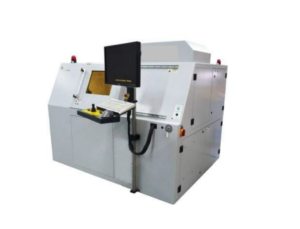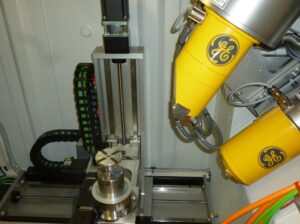In 2015, the Regensburg Center of Biomedical Engineering (RCBE) commissioned the micro-computer tomograph (Micro-CT) at the Ostbayerische Technische Hochschule Regensburg (OTH Regensburg) funded by the German Research Foundation (DFG). The X-ray testing system phoenix v|tome|xs 240/180 from Baker Hughes Digital Solutions GmbH is interdisciplinary and is located in the Faculty of Mechanical Engineering at OTH Regensburg.
 For many topics from a wide range of disciplines, it is crucial to know what it looks like “inside” an exhibit. Typically, methods that destroy or alter the exhibit are used for this purpose. Micro-CT, on the other hand, which works with X-rays, can reveal the hidden interior of objects of examination without causing damage or destruction. No special preparation, such as scanning electron microscopy, is required either. The CT also includes a high-performance graphics card-accelerated workstation with specialized software to process and visualize raw data, as well as to measure a large number of parameters.
For many topics from a wide range of disciplines, it is crucial to know what it looks like “inside” an exhibit. Typically, methods that destroy or alter the exhibit are used for this purpose. Micro-CT, on the other hand, which works with X-rays, can reveal the hidden interior of objects of examination without causing damage or destruction. No special preparation, such as scanning electron microscopy, is required either. The CT also includes a high-performance graphics card-accelerated workstation with specialized software to process and visualize raw data, as well as to measure a large number of parameters.
The device is available to Campus Regensburg for research tasks and is integrated into research projects and development contracts.
The device is also available for contract research.
Technical Data
 The direct x-ray tube (= D-tube) has a maximum voltage of 240 kV and the transmission X-ray tube (= NF-tube) has a maximum voltage of 180 kV.
The direct x-ray tube (= D-tube) has a maximum voltage of 240 kV and the transmission X-ray tube (= NF-tube) has a maximum voltage of 180 kV.
In total, the following performance values of the X-ray tubes are obtained:
| D-tube | NF-tube | |
|
high voltage [kV]
|
10 – 240 | 10 – 180 |
| X-ray tube current [µA] | 5 – 3000 | 5 – 880 |
|
Thickness of the target
(radiation emersion window) [mm] |
0,5 | 0,4 |
-
Recording software: phoenix datos|x 2 acquisition 2.5.1
-
Reconstruction software: phoenix datos|x 2 reconstruction 2.5.1
-
Evaluation software: Volume Graphics VG Studio Max 2.2.3
- Number of axles: max. 5
- Weight of test specimen: max. 10 kg
- Measurements of test specimen (max. ): 260 mm diameter, 400 mm height
- Rotation: 360 °
- Axle speed: min. 10 μm/s
- Axle speed: max. 80 mm/s
3D Computerized Tomography (3D CT)
The material to be examined (= test specimen) is penetrated by the X-ray radiation generated in the X-ray tube, which is attenuated to different degrees depending on the material and measured by a detector. This allows non-destructive images of complex external and internal structures of the test object to be generated.
Several X-rays of the specimen from different directions are taken to represent a three-dimensional image. The object to be measured rotates 360° around its own axis between the X-ray tube and the detector on a rotary controller. A 3D volume model is calculated from the images.
The micro-computer tomograph v|tome|xs 240/180 has two different X-ray tubes for a wide range of applications. The NF tube is suitable for mainly weakly absorbing very small objects, which require a high degree of detail recognition. The more powerful D-tube is used for low to high absorbing materials.
Applications
- High resolution display of 3D volumes
- Non-destructive material testing for cracks, inclusions, etc.
- Analysis methods such as defect analysis, pore and inclusion analysis, fiber orientation analysis, etc.
- Measurements of geometries (surfaces, volumes, morphometry such as bone surface/bone volume, average trabecular thickness, etc. )



